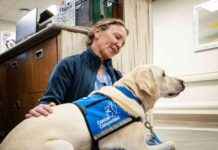Chikao Tsubaki, an elderly man in his mid-80s, faced a series of health challenges, including a stroke, lymphoma, and prostate cancer. Fatigued, isolated, and unsteady, Tsubaki’s quality of life was at risk. However, his life took a positive turn when he became involved in a unique care initiative called Community Aging in Place: Advancing Better Living for Elders (CAPABLE). Over four months, a team of professionals, including an occupational therapist, a nurse, and a handy worker, visited Tsubaki’s home to assess his needs and ensure his safety. In addition to practical modifications like grab bars and rails, the handy worker built a bookshelf to prevent accidents and support Tsubaki’s love for reading.
Tsubaki, a former community college teacher, emphasized the importance of reading for his cognitive health, describing it as a form of mental exercise. Now 87 years old, he enjoys independent living and takes daily walks, covering a mile and a half. The CAPABLE program, which has been in operation for 15 years and is available in 65 locations across 26 states, offers assistance to individuals aged 60 and above who wish to remain in their homes but struggle with daily activities like bathing, dressing, and moving safely.
Despite the proven benefits and positive outcomes associated with CAPABLE, the program’s reach remains limited, serving only around 4,600 people to date. One of the primary challenges is the lack of insurance coverage. While the cost per client, ranging from $3,500 to $4,000, is relatively low compared to other healthcare interventions, traditional Medicare and most Medicare Advantage plans do not cover CAPABLE services. Only four states utilize Medicaid funds to support the program, which relies on a patchwork of grants from various sources to sustain its operations.
The payment barriers faced by CAPABLE highlight the existing limitations in the healthcare system, which tends to prioritize medical treatments over preventive community services. Medicare’s billing codes are designed to cover treatments for existing health conditions rather than proactive measures to maintain wellness and prevent injuries. The program’s ability to save money and prevent falls, which are significant contributors to older Americans’ deaths and Medicare costs, is often overlooked due to the lack of appropriate reimbursement mechanisms.
Sarah Szanton, a nurse practitioner who played a key role in creating CAPABLE, shared her frustrations regarding the challenges in securing broader state or federal financing for the program. Drawing inspiration from a successful program called ABLE, which focused on occupational therapy and home modifications, Szanton developed CAPABLE in 2008. The addition of a nurse to address medication management, pain relief, and mental health needs enhanced the program’s effectiveness in supporting participants’ overall well-being.
CAPABLE’s model, characterized by active client participation and collaborative problem-solving with the care team, has shown promising results in enabling older adults to live safely at home with improved mobility. While the program does not address all long-term care gaps and excludes individuals with dementia, studies indicate that it can lead to significant Medicare savings and long-term benefits for participants. The success of CAPABLE in enhancing seniors’ independence and quality of life underscores the potential impact of community-based care initiatives in the healthcare landscape.
Moving forward, there are opportunities for broader coverage of CAPABLE services under Medicare, but several considerations need to be addressed. Establishing clear eligibility criteria, ensuring cost-effective home modifications, and preventing potential exploitation by contractors are some of the key challenges that policymakers and healthcare experts must navigate. By incorporating safeguards and refining operational processes, programs like CAPABLE can continue to make a meaningful difference in the lives of older adults seeking to age independently and safely at home.
For individuals like Chikao Tsubaki, whose life has been positively transformed by the support and services provided through CAPABLE, the lasting benefits are a testament to the program’s impact. With improved independence and enhanced daily functioning, Tsubaki’s story exemplifies the potential of community-based care models to empower older adults and facilitate active aging. As he navigates his daily routines with a renewed sense of autonomy and purpose, Tsubaki’s journey serves as a reminder of the transformative power of personalized, home-based care initiatives like CAPABLE.

















